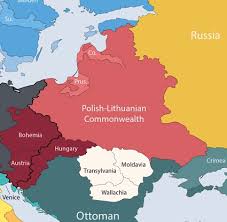 |
| The Baltic Giant’s Journey: Lithuania’s Royal Past, Polish Union, and Rebirth After Soviet Control |
Early Origins: Where Did Lithuanians Come From?
The Lithuanians are one of the oldest surviving Indo-European ethnic groups. They trace their origins to the Baltic tribes, which settled along the southeastern coast of the Baltic Sea thousands of years ago. Archaeological evidence points to human habitation in the area as early as 10,000 BCE.
By the 9th and 10th centuries, these tribes began consolidating into a more unified political structure. The name “Lithuania” was first mentioned in written sources in 1009 AD in the Annals of Quedlinburg.
Formation of the Grand Duchy: When Was Lithuania Founded?
Lithuania was founded in 1236, when Grand Duke Mindaugas unified the Baltic tribes and established the Grand Duchy of Lithuania. He was later crowned as Lithuania’s first and only king in 1253. This event is often considered the official beginning of the Lithuanian state.
During the 14th century, Lithuania expanded rapidly, becoming one of the largest countries in Europe. The Lithuania history map of that era shows a vast territory stretching from the Baltic Sea to the Black Sea, incorporating parts of modern-day Belarus, Ukraine, Poland, and Russia.
Christianization and the Polish-Lithuanian Union
For centuries, Lithuania’s history was marked by a deep-rooted pagan belief system. It was the last pagan nation in Europe, officially adopting Christianity in 1387 under Grand Duke Jogaila, who also became King of Poland. This conversion marked a crucial cultural and political transformation.
The Union of Krewo in 1385 and the later Union of Lublin in 1569 created the Polish-Lithuanian Commonwealth, one of the largest and most populous states in Europe. This period brought prosperity, political influence, and a flourishing Lithuania history and culture.
Foreign Dominance and Partition
The 18th century marked the decline of the Commonwealth. By the end of the 1700s, Lithuania was absorbed into the Russian Empire as part of the Partitions of Poland. For over a century, Lithuanians endured forced Russification, suppression of their language, and religious persecution.
Lithuania Before 1918: What Was Lithuania?
What was Lithuania before 1918? Before gaining independence in the 20th century, Lithuania had spent over a century under Russian imperial control. Despite suppression, nationalist movements emerged, emphasizing the preservation of the Lithuanian language, identity, and the push for independence.
The History of Lithuania book is filled with stories of resistance, cultural revival, and underground education efforts during this time.
Independence and Interwar Period
On February 16, 1918, Lithuania declared independence following World War I and the collapse of the Russian Empire. This marked a short-lived yet significant period of self-rule, modernization, and nation-building.
However, this independence was interrupted by Soviet and Nazi occupations during World War II. Lithuania was forcibly incorporated into the Soviet Union in 1940, leading to mass deportations and suppression of national identity.
Soviet Rule and the Struggle for Freedom
From 1940 to 1990, Lithuania remained under Soviet control, enduring harsh repression. Yet, underground movements and cultural preservation persisted.
The 1980s saw the rise of the Sąjūdis independence movement. On March 11, 1990, Lithuania have become the primary Soviet republic to claim independence, putting a precedent for different nations.
Modern Lithuania: Sovereignty and Progress
Since regaining independence, Lithuania has transformed into a vibrant democratic state. It joined the European Union and NATO in 2004, and has rapidly modernized its economy, society, and international standing.
The Lithuania currency is the Euro (EUR), adopted in 2015, replacing the Lithuanian litas.
Religion in Lithuania: What Religion Is in Lithuania?
Roman Catholicism is the dominant religion in Lithuania, practiced by over 75% of the population. The faith plays a significant role in national identity and cultural traditions. There are also minority communities of Orthodox Christians, Protestants, and Jews.
What Is Lithuania Known for in History?
Lithuania is known for:
-
Being the last pagan nation in Europe to adopt Christianity (1387)
-
Establishing the powerful Grand Duchy of Lithuania
-
Forming the Polish-Lithuanian Commonwealth, a major European power
-
Leading the way to freedom from Soviet rule in 1990
-
Preserving a strong national identity through centuries of foreign domination
What Are 5 Facts About Lithuania?
-
Lithuania was once the largest country in Europe during the 14th century.
-
It was the first Soviet republic to declare independence in 1990.
-
Vilnius, the capital, is known for its Baroque architecture and medieval Old Town.
-
Lithuania is home to one of the oldest languages in the world—Lithuanian, a Baltic language close to ancient Sanskrit.
-
The Hill of Crosses in Šiauliai is a powerful symbol of faith and resistance.
History of Lithuania Resources
For more in-depth information, consider these sources:
-
History of Lithuania Wikipedia – A comprehensive online resource.
-
History of Lithuania Timeline – A chronological overview of major events.
-
History of Lithuania Book – Titles by authors like Alfonsas Eidintas or Timothy Snyder provide scholarly insights.
-
Lithuania History Map – Historical atlases illustrate the changing borders and influence of the Lithuanian state.
Conclusion!
The history of Lithuania is a story of survival, identity, and enduring spirit. From tribal beginnings and grand empires to foreign occupations and modern independence, Lithuania’s past is rich and instructive. Whether exploring the history of Lithuania Wikipedia, delving into a book, or walking the streets of Vilnius, one experiences a nation that honors its history while embracing the future.




